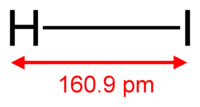Hydrogen iodide
 |
|
 |
|
| Names | |
|---|---|
|
IUPAC name
Iodane
|
|
| Other names
Hydroiodic acid (aqueous solution)
Iodine hydride |
|
| Identifiers | |
|
10034-85-2 |
|
| 3D model (Jmol) | Interactive image |
| ChemSpider |
23224 |
| PubChem | 16109203 |
| RTECS number | MW3760000 |
| UNII |
694C0EFT9Q |
|
|
|
|
| Properties | |
| HI | |
| Molar mass | 127.904 g/mol |
| Appearance | Colorless gas |
| Density | 2.85 g/mL (−47 °C) |
| Melting point | −50.80 °C (−59.44 °F; 222.35 K) |
| Boiling point | −35.36 °C (−31.65 °F; 237.79 K) |
| approximately 245 g/100 ml | |
| Acidity (pKa) | −10 (in water, estimate); -9.5 (±1.0) 2.8 (in acetonitrile) |
| Structure | |
| Terminus | |
| 0.38 D | |
| Hazards | |
| Main hazards | Toxic, corrosive, Harmful and Irritant |
| Safety data sheet |
See: data page hydrogen iodide hydroiodic acid |
| R-phrases | R20, R21, R22, R35 |
| S-phrases | S7, S9, S26, S45 |
| NFPA 704 | |
| Flash point | Non-flammable |
| Related compounds | |
|
Other anions
|
Hydrogen fluoride Hydrogen chloride Hydrogen bromide Hydrogen astatide |
| Supplementary data page | |
|
Refractive index (n), Dielectric constant (εr), etc. |
|
|
Thermodynamic
data |
Phase behaviour solid–liquid–gas |
| UV, IR, NMR, MS | |
|
Except where otherwise noted, data are given for materials in their standard state (at 25 °C [77 °F], 100 kPa).
|
|
|
|
|
| Infobox references | |
2.8 (in acetonitrile)
Hydrogen iodide (HI) is a diatomic molecule and hydrogen halide. Aqueous solutions of HI are known as hydroiodic acid or hydriodic acid, a strong acid. Hydrogen iodide and hydroiodic acid are, however, different in that the former is a gas under standard conditions, whereas the other is an aqueous solution of said gas. They are interconvertible. HI is used in organic and inorganic synthesis as one of the primary sources of iodine and as a reducing agent.
HI is a colorless gas that reacts with oxygen to give water and iodine. With moist air, HI gives a mist (or fumes) of hydroiodic acid. It is exceptionally soluble in water, giving hydroiodic acid. One liter of water will dissolve 425 liters of HI, the most concentrated solution having only four water molecules per molecule of HI.
Hydroiodic acid is not pure hydrogen iodide, but a mixture containing it. Commercial "concentrated" hydroiodic acid usually contains 48–57% HI by mass. The solution forms an azeotrope boiling at 127 °C with 57% HI, 43% water. The high acidity is caused by the dispersal of the ionic charge over the anion. The iodide ion is much larger than the other common halides, which results in the negative charge being dispersed over a large space. By contrast, a chloride ion is much smaller, meaning its negative charge is more concentrated, leading to a stronger interaction between the proton and the chloride ion. This weaker H+···I− interaction in HI facilitates dissociation of the proton from the anion and is the reason HI is the strongest acid of the hydrohalides.
The industrial preparation of HI involves the reaction of I2 with hydrazine, which also yields nitrogen gas:
...
Wikipedia

